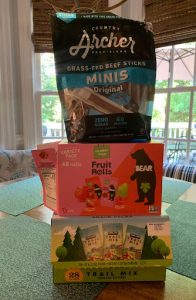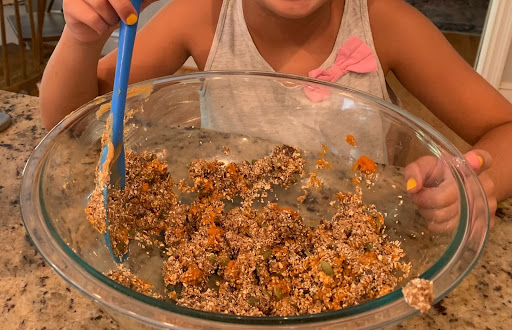Last week at Costco, my children and I engaged in a back-to-school debate lesson. They wanted certain snacks, and I wanted them to have others. We had to negotiate. As an ISSA certified nutritionist, I realize how some portable snacks are a better buy than others. As kids with a goldfish dependency and sweet and salty cravings, my two are more interested in something delicious and fun (preferably with a crude joke or cute art on the wrapper.)
 We left with these three items:
We left with these three items:
1. Archer mini beef sticks
2. BEAR fruit rolls
3. Kirkland trail mix snack packs
The beef sticks are surprisingly lower sodium than I expected and a source of 4 grams of protein. The fruit rolls offer 2 grams of dietary fiber per serving. Both of these snacks have zero added sugars, which is helpful as well. The trail mix is a good source of protein and fiber plus healthy fats. The Kirkland brand is also lower in sodium and added sugar than most packaged, processed trail mix snacks. The caveat, however, is that one pack is actually two servings — even though one pack is as small as a deck of cards.
There are plenty of hurdles to cross as a parent trying to send a child off ready to learn and play. Snacks should not be one of those.
Here are some tips to help lessen the confusion on healthy snacks:
Seek out two key nutrients. Very few convenience snacks have it all, so aim for those with the least added sugars that also offer two elements of value like protein, fiber, and healthy fat. If only one nutrient is available in a snack, try pairing it with another containing some other nutrient.
Understand how low to high works. Most food labels show percentages for certain nutrients. These signify how much of a daily value is provided by a serving of the product. Based on 2,000 calorie diets, 5% or less is low, and 20% or more is high. This can help simplify the process of reading labels.
Be aware of serving sizes. This can be tricky. You might think a wrapped snack is a single serving when it might be two or even more. This means you might have to double or even triple those values.
Go back, when you can, to OG to-go snacks. There is nothing wrong with sending a kid off with an apple, banana, or orange and a small container of nuts, seeds, or chilled cheese sticks. How about a bag of home-popped popcorn? All of these are less processed, quality nutrient sources that travel well, too.
Pumpkin Spice Energy Balls
Here is a recipe I developed for the coming of fall that you might enjoy trying to make with your children. Little kids to teens can help prepare the recipe. Energy balls are good sources of protein, fiber, and healthy fat. Keeping added sugars in check makes them even sweeter. They are fun to make, easy to adjust, and satisfying snacks. Be sure to not waste that leftover pumpkin puree either. It is a key ingredient for these pumpkin chocolate chip muffins (another snack idea or quick breakfast).
Yield: 20 to 24 balls
Ingredients
1 cup oats
⅓ cup nut or seed butter (I used peanut butter.)
2 Tablespoons maple syrup (or honey)
2 Tablespoons ground flax
3 Tablespoons pepitas (I used the raw unsalted pumpkin seeds.)
3 Tablespoons chocolate chips or chunks (I used 75% cacao chunks.)
½ teaspoon cinnamon
Pinch of ground ginger
Pinch of nutmeg
Pinch of ground cloves
2 Tablespoons canned 100% pure pumpkin puree
Instructions
Grind oats in a food processor to a flour-like consistency.
Combine oats in a mixing bowl with all other ingredients, stirring in the pumpkin puree last to moisten.
Roll into small to medium balls.
Refrigerate and enjoy for about a week.
Note: These freeze well, too. They thaw in the refrigerator or on the counter to enjoy within about 20 minutes. You can find ground flax or flax seed meal in the flour section. Pepitas are usually available near dried fruits and bulk nuts.




2 comments
YUMMMM, totally making these!!
If you chop up the chunks, there is more chocolate to enjoy in each bite. These are like a cross between sweet treat and snack to me! Hope you enjoy.